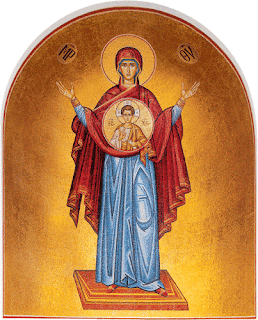
The following icon and quotation is from our wall calendar. It is May, and in the Catholic Church May is Mary's month. For she is the Most Holy Theotokos, the Mother of God. While I love the Latin-rite, or Roman, Catholic Church, my heart is also Eastern and I would be a very happy Eastern-rite Catholic. Every parish needs to be filled with iconography such as this.
"Blessed are you among women, and blessed is the fruit of your womb!" (Lk 1.42).
The tabernacle in Eastern Catholic churches sits upon the main Altar of Sacrifice. Hovering above that tabernacle on the back wall or ceiling of the sanctuary is the icon of the Mother of God known in Greek as the "Platytera," which means "more spacious than the Heavens." The liturgical text proclaims: "He whom not even the universe could contain was contained within the womb of a virgin, making her more spacious than the Heavens." Mary, the Mother of God becomes, therefore, a mystical or human "tabernacle." Like the tabernacle that rests upon the Altar, Mary's body contained the body of Jesus Christ. The Platytera icon is designed as though we were looking into the very womb of the mystical tabernacle. Mary presents Christ to us from the very heart of her own being. She is adorned in a regal red, symbolizing her dignity as the queen of heaven. Red is also the color of clay or earth, and it is from Mary that the Second Person of the Trinity receives His human nature.
The stars on Mary's forehead and on each of her shoulders refer to her virginity before, during, and after the birth of Christ. On either side of her are the ancient Greek abbreviations for "Theotokos," meaning literally, "God-bearer." In this way, the icon makes a statement about both Christ's divinity and Mary's nature: The human child she carried in her womb was at the same time God, thus making her the "God-bearer."
Gazing upon this icon, the viewer can see the very meaning of womanhood. Because the very body of every woman is configured to the body of the "human tabernacle," so too does every woman carry within her a "sacred space," making the body of every woman, in a certain sense, intrinsically holy, a "tabernacle."
No comments:
Post a Comment